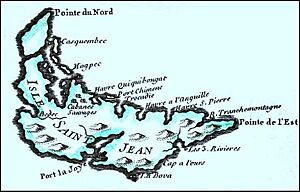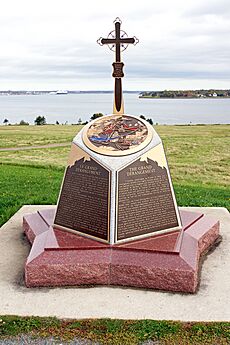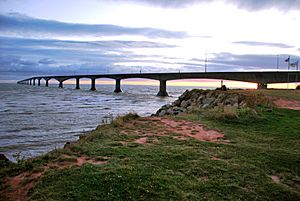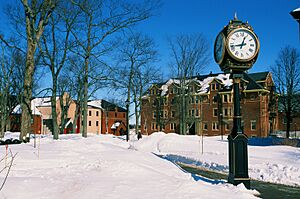History of Prince Edward Island facts for kids
Prince Edward Island has a long and interesting history, stretching from ancient times to today. Long before Europeans arrived, the island was home to the Mi'kmaq people, who called it Mi'kma'ki. Europeans first explored the island in the 1500s. In 1604, France claimed the entire Maritimes region, including PEI. However, the French didn't start a settlement until 1720, when they created the colony of Île Saint-Jean. After the British took over Acadia (now Nova Scotia) in 1710, many Acadian people moved to places still controlled by the French, like Île Saint-Jean.
In 1758, the British took control of the island during the Seven Years' War. Soon after, British forces began to move many Acadians off the island. The island officially became the British colony of St. John Island in 1769. It was later renamed Prince Edward Island in 1798. Even though the island's capital, Charlottetown, hosted an important meeting that led to Canadian Confederation in 1867, the colony didn't join Canada until 1873.
Contents
Early History of Prince Edward Island
Prince Edward Island was first settled by the Mi'kmaq people. They have lived in this area for thousands of years. They called the island Epekwitk, which means "cradle on the waves." The Mi'kmaq believe the island was formed when a great spirit placed dark red clay, shaped like a crescent, on pink waters. Today, there are two Mi'kmaq First Nation reserves on Prince Edward Island.
French Colony on the Island
In 1604, France claimed the lands of the Maritimes and created the colony of Acadia. After the Treaty of Utrecht in 1713, the island was called Île Saint-Jean. The first French settlers arrived in 1719 after their ship was wrecked at Naufrage. These settlers mainly lived at Port-LaJoye and Havre Saint-Pierre (St. Peter's Harbour). Port-LaJoye had an administrative office and a small army group. Havre Saint-Pierre remained the largest settlement during the French control of the island.
King George's War and the Island
During King George's War, after the Siege of Louisbourg (1745), New Englanders also captured Île Saint-Jean. An English group landed at Port-la-Joye. The French had 20 soldiers there, but they fled. The New Englanders then burned the capital. The French soldiers and their allies, the Acadians and Mi'kmaq, fought back and pushed the New Englanders away. The New Englanders took six Acadian hostages, threatening to harm them if the Acadians or Mi'kmaq rebelled.
Battle at Port-la-Joye
The New Englanders had two warships and 200 soldiers at Port-LaJoye. To try and take back Acadia, a French commander named Ramezay sent Joseph-Michel Legardeur de Croisille et de Montesson with over 500 men, including 200 Mi'kmaq, to Port-LaJoye. In July 1746, a battle took place near York River. Montesson and his troops killed forty New Englanders and captured the rest.
Acadian People on the Island
During Father Le Loutre's War, many Acadians moved to the island from mainland Nova Scotia. The island's population grew quickly from 735 to about three thousand people. New settlements started in places like Pointe-Prime (Eldon) and Bedec.
The British captured Port Royal, the capital of Acadia, in 1710. They then created Nova Scotia. For the next 45 years, the Acadians refused to promise their full loyalty to Britain. During this time, Acadians and Mi'kmaq helped fight against the British. They also kept important supply routes open to the French fortresses of Louisbourg and Fort Beausejour. During the French and Indian War, the British decided to move the Acadians away to stop them from being a threat and to cut off their supplies to Louisbourg.
When the first wave of Acadians were moved from mainland Nova Scotia, many came to the island as refugees. After the Siege of Louisbourg (1758), the second wave of Acadians were moved. By 1758, the island's population had grown to almost 5,000. Commander Rollo led the effort to move Acadians from the island. One well-known example was the removal of Noel Doiron and his family from Eldon.
Prince Edward Island as a British Colony
In 1763, the British claimed control over all of the Maritimes. A separate colony called "St. John's Island" was created on June 28, 1769. This happened after the island's settlers worked hard to make it happen.
American Revolutionary War Impact
During the American Revolutionary War, Charlottetown was attacked in 1775 by two American privateer ships. These ships, the Franklin and Hancock, captured the acting Governor Phillips Callbeck and other officials in Charlottetown.
During and after the war, the colony tried to attract Loyalist refugees from the United States. Many Loyalists, who supported Britain, moved to the island. Prince Edward Island became a popular place for wealthy British families to visit in the 1700s.
New Names for the Island
In 1798, Great Britain changed the colony's name from St. John's Island to Prince Edward Island. This was done to avoid confusion with other places like Saint John and St. John's. The new name honored Prince Edward Augustus, the Duke of Kent, who was King George III's fourth son. He was leading British troops in Halifax at the time. (Prince Edward later became the father of Queen Victoria.)
Most of the colony's land was owned by wealthy British landlords who didn't live on the island. This led to long-lasting disagreements between the government, the people living on the land, and these absentee landlords. These disputes continued until the island joined Canada.
Towards Canadian Confederation
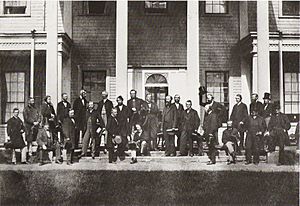
In September 1864, Prince Edward Island hosted the Charlottetown Conference. This was the very first meeting that led to Canadian Confederation and the creation of Canada in 1867. However, Prince Edward Island didn't like the terms of joining Canada and chose to remain a separate British colony in 1867.
In the late 1860s, the colony looked at different options. This included possibly becoming its own country. They also talked with representatives from the United States, who were interested in Prince Edward Island joining the U.S.
Joining Canadian Confederation
In the early 1870s, the colony started building a railway. They also began talks with the United States, as they were frustrated with Great Britain. In 1873, Prime Minister Sir John A. Macdonald wanted to stop the U.S. from expanding. He also faced problems with the Pacific Scandal. So, he negotiated for Prince Edward Island to join Canada. The Canadian government agreed to take over the colony's railway debts. They also agreed to pay to buy out the last of the absentee landlords. This freed the island from the old land ownership system. Prince Edward Island joined Confederation on July 1, 1873. The problem of absentee landowners was later solved by the Land Purchase Act, 1875.
Prince Edward Island After Confederation
Because Prince Edward Island hosted the first meeting about Confederation, it calls itself the "Birthplace of Confederation." Many buildings, a ferry vessel, and the Confederation Bridge (the longest bridge over ice-covered waters in the world) use the word "confederation" in their names. The most famous building with this name is the Confederation Centre of the Arts. It was given as a gift to Islanders by the ten provincial governments and the Canadian government in 1964. It is a national monument to the "Fathers of Confederation."
Religion played a big role in how institutions developed. There were separate public schools for Protestants and Roman Catholics. Hospitals and colleges also had religious ties. For example, Prince of Wales College and St. Dunstan's University were two different colleges.
Like most places in North America, the automobile changed Charlottetown a lot in the second half of the 1900s. Farms in areas like Brighton and Spring Park became places with more houses. The Charlottetown airfield was improved during World War II as part of the British Commonwealth Air Training Plan. It was used as RCAF Station Charlottetown during the war. After the war, it became Charlottetown Airport. Charlottetown's shipyards were also used a lot during World War II to fix and upgrade many Royal Canadian Navy warships.
To celebrate 100 years since the Charlottetown Conference, the provincial and federal governments built the Confederation Centre of the Arts. It opened in 1964 and was a gift to the people of Prince Edward Island. It has a public library, an art gallery, and a main theatre that hosts the Charlottetown Festival every summer. In 1969, Saint Dunstan's University and Prince of Wales College joined to form the University of Prince Edward Island (UPEI).
The Queen Elizabeth Hospital opened in 1982. In 1983, the national office for the federal Department of Veterans Affairs moved to Charlottetown. This was part of a plan to spread government offices across Canada. In 1986, UPEI grew even more with the opening of the Atlantic Veterinary College. Throughout the 1970s and 1980s, more offices and shops were built. A hotel and convention centre opened in 1982, helping to bring new life to the downtown area. When CN Rail stopped train service in 1989, the old railway lands were turned into parks and cultural attractions.
On May 31, 2021, the Charlottetown City Council voted to remove a statue of John A. Macdonald, Canada's first Prime Minister. This decision followed a year of vandalism and came after the discovery of a mass grave at the Kamloops Indian Residential School in British Columbia.
See also


